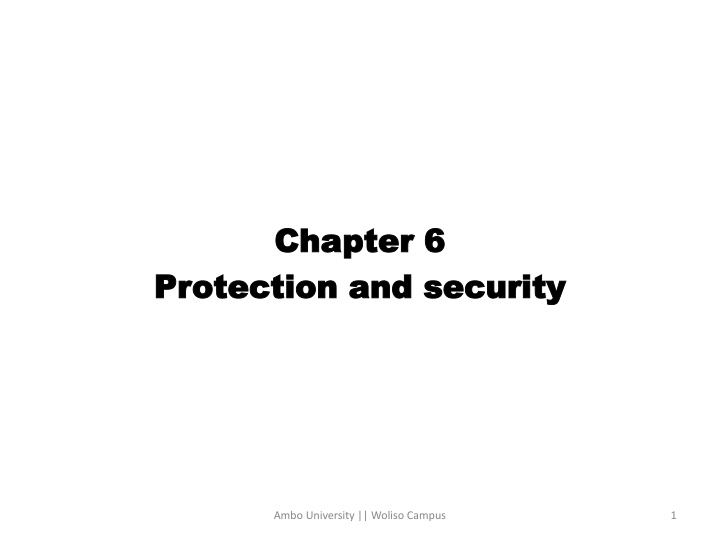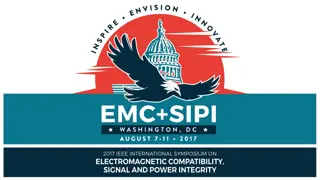
Principles of Protection and Security in Computer Systems at Ambo University
Explore the goals, principles, and implementation of protection and security measures in computer systems at Ambo University's Woliso Campus. Learn about access matrices, capability-based systems, and more to ensure proper access control and privilege management. Understand the importance of domain switching, privilege escalation, and safeguarding data access.
Download Presentation

Please find below an Image/Link to download the presentation.
The content on the website is provided AS IS for your information and personal use only. It may not be sold, licensed, or shared on other websites without obtaining consent from the author. If you encounter any issues during the download, it is possible that the publisher has removed the file from their server.
You are allowed to download the files provided on this website for personal or commercial use, subject to the condition that they are used lawfully. All files are the property of their respective owners.
The content on the website is provided AS IS for your information and personal use only. It may not be sold, licensed, or shared on other websites without obtaining consent from the author.
E N D
Presentation Transcript
Chapter 6 Chapter 6 Protection and security Protection and security Ambo University || Woliso Campus 1
6.1 Protection 6.1 Protection Ambo University || Woliso Campus 2
Contents o Goals of protection o Principles of protection o Access matrices' o Access matrices' implementation o Capability based protection system o Language based protection system Ambo University || Woliso Campus 3
Goals of protection o In one protection model, computer consists of a collection of objects, hardware or software o Each object has a unique name and can be accessed through a well-defined set of operations o Protection problem - ensure that each object is accessed correctly and only by those processes that are allowed to do so Ambo University || Woliso Campus 4
Principles of protection o Guiding principle principle of least privilege Programs, users and systems should be given just enough privileges to perform their tasks Limits damage if entity has a bug, gets abused Can be static (during life of system, during life of process) Or dynamic (changed by process as needed) domain switching, privilege escalation Need to know a similar concept regarding access to data Ambo University || Woliso Campus 5
Principles of protection o Must consider grain aspect Rough-grained privilege management easier, simpler, but least privilege now done in large chunks For example, traditional Unix processes either have abilities of the associated user, or of root Fine-grained management more complex, more overhead, but more protective File ACL lists, RBAC o Domain can be user, process, procedure Ambo University || Woliso Campus 6
Domain structure o Access-right = <object-name, rights-set> where rights-set is a subset of all valid operations that can be performed on the object o Domain = set of access-rights Ambo University || Woliso Campus 7
Access matrics oView protection as a matrix (access matrix) oRows represent domains oColumns represent objects oAccess(i,j) is the set of operations that a process executing in Domaini can invoke on Objectj Ambo University || Woliso Campus 8
Use of Access Matrix o If a process in Domain Ditries to do op on object Oj, then op must be in the access matrix o User who creates object can define access column for that object o Can be expanded to dynamic protection Operations to add, delete access rights Special access rights: owner of Oi copy op from Oi to Oj (denoted by * ) control Di can modify Dj access rights transfer switch from domain Di to Dj Copy and Owner applicable to an object Control applicable to domain object Ambo University || Woliso Campus 9
Access Matrix of Figure A with Domains as Objects Ambo University || Woliso Campus 10
Access Matrix with Copy Rights Ambo University || Woliso Campus 11
Access Matrix With Owner Rights Ambo University || Woliso Campus 12
Modified Access Matrix of Figure B Ambo University || Woliso Campus 13
Implementation of Access Matrix o Generally, a sparse matrix o Option 1 Global table Store ordered triples <domain, object, rights-set> in table A requested operation M on object Oj within domain Di -> search table for < Di, Oj, Rk > with M Rk But table could be large -> won t fit in main memory Difficult to group objects (consider an object that all domains can read) Ambo University || Woliso Campus 14
Implementation of Access Matrix (Cont.) o Option 2 Access lists for objects Each column implemented as an access list for one object Resulting per-object list consists of ordered pairs <domain, rights-set> defining all domains with non-empty set of access rights for the object Easily extended to contain default set - > If M default set, also allow access Ambo University || Woliso Campus 15
Implementation of Access Matrix (Cont.) o Each column = Access-control list for one object Defines who can perform what operation Domain 1 = Read, Write Domain 2 = Read Domain 3 = Read o Each Row = Capability List (like a key) For each domain, what operations allowed on what objects Object F1 Read Object F4 Read, Write, Execute Object F5 Read, Write, Delete, Copy Ambo University || Woliso Campus 16
Implementation of Access Matrix (Cont.) o Option 3 Capability list for domains Instead of object-based, list is domain based Capability list for domain is list of objects together with operations allows on them Object represented by its name or address, called a capability Execute operation M on object Oj, process requests operation and specifies capability as parameter Possession of capability means access is allowed Capability list associated with domain but never directly accessible by domain Rather, protected object, maintained by OS and accessed indirectly Like a secure pointer Idea can be extended up to applications Ambo University || Woliso Campus 17
Implementation of Access Matrix (Cont.) o Option 4 Lock-key Compromise between access lists and capability lists Each object has list of unique bit patterns, called locks Each domain as list of unique bit patterns called keys Process in a domain can only access object if domain has key that matches one of the locks Ambo University || Woliso Campus 18
Comparison of Implementations o Many trade-offs to consider Global table is simple, but can be large Access lists correspond to needs of users Determining set of access rights for domain non-localized so difficult Every access to an object must be checked Many objects and access rights -> slow Capability lists useful for localizing information for a given process But revocation capabilities can be inefficient Lock-key effective and flexible, keys can be passed freely from domain to domain, easy revocation Ambo University || Woliso Campus 19
Comparison of Implementations (Cont.) o Most systems use combination of access lists and capabilities First access to an object -> access list searched If allowed, capability created and attached to process Additional accesses need not be checked After last access, capability destroyed Consider file system with ACLs per file Ambo University || Woliso Campus 20
Access Control o Protection can be applied to non-file resources o Oracle Solaris 10 provides role-based access control (RBAC)to implement least privilege Privilegeis right to execute system call or use an option within a system call Can be assigned to processes Users assigned roles granting access to privileges and programs Enable role via password to gain its privileges Similar to access matrix Ambo University || Woliso Campus 21
Revocation of Access Rights o Various options to remove the access right of a domain to an object Immediate vs. delayed Selective vs. general Partial vs. total Temporary vs. permanent o Access List Delete access rights from access list Simple search access list and remove entry Immediate, general or selective, total or partial, permanent or temporary Ambo University || Woliso Campus 22
Revocation of Access Rights (Cont.) o Capability List Scheme required to locate capability in the system before capability can be revoked Reacquisition periodic delete, with require and denial if revoked Back-pointers set of pointers from each object to all capabilities of that object (Multics) Indirection capability points to global table entry which points to object delete entry from global table, not selective (CAL) Keys unique bits associated with capability, generated when capability created Master key associated with object, key matches master key for access Revocation create new master key Policy decision of who can create and modify keys object owner or others? Ambo University || Woliso Campus 23
Capability-Based Systems o Hydra Fixed set of access rights known to and interpreted by the system i.e. read, write, or execute each memory segment User can declare other auxiliary rights and register those with protection system Accessing process must hold capability and know name of operation Rights amplification allowed by trustworthy procedures for a specific type Interpretation of user-defined rights performed solely by user's program; system provides access protection for use of these rights Operations on objects defined procedurally procedures are objects accessed indirectly by capabilities Solves the problem of mutually suspicious subsystems Includes library of prewritten security routines Ambo University || Woliso Campus 24
Capability-Based Systems (Cont.) o Cambridge CAP System Simpler but powerful Data capability - provides standard read, write, execute of individual storage segments associated with object implemented in microcode Software capability -interpretation left to the subsystem, through its protected procedures Only has access to its own subsystem Programmers must learn principles and techniques of protection Ambo University || Woliso Campus 25
Language-Based Protection o Specification of protection in a programming language allows the high-level description of policies for the allocation and use of resources o Language implementation can provide software for protection enforcement when automatic hardware-supported checking is unavailable o Interpret protection specifications to generate calls on whatever protection system is provided by the hardware and the operating system Ambo University || Woliso Campus 26
The end The end Thank you Thank you Ambo University || Woliso Campus 27

















